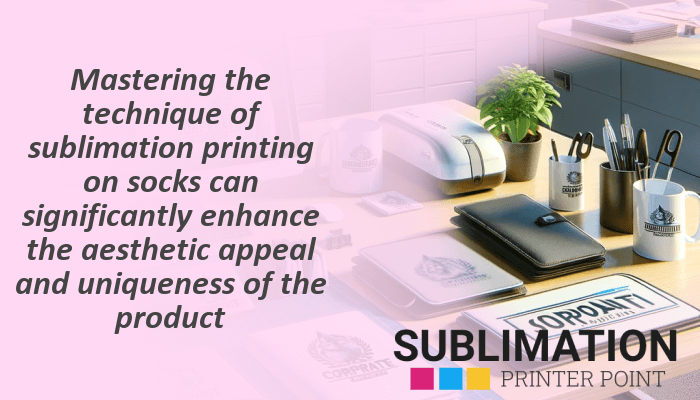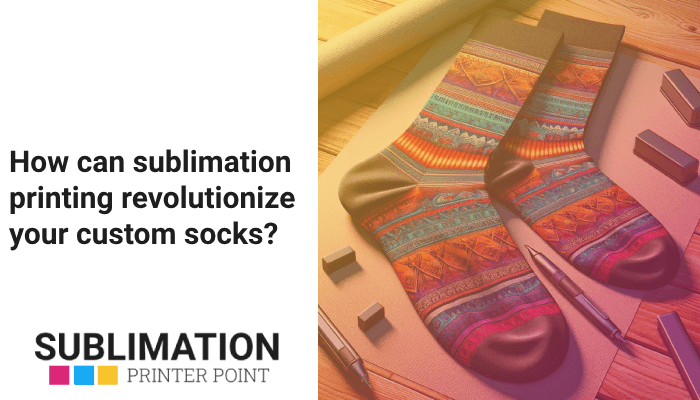Sublimation on socks is made possible by the sublimation printing method. This method uses heat to impart color to different materials creating durable graphics and is widely used to produce unique textile products.
By using heat to transfer dye onto materials like plastic, card, paper, or cloth, sublimation printing is a digital technology. It’s very popular for making bespoke socks because of the vibrant, long-lasting designs it creates. Paper, a heat press, and sublimation ink are needed for the process. When heated, the ink bypasses the liquid stage and forms a bond with the polyester fibers as a gas. This produces a design that will not only stand the test of time, but also be colorful.
- Sublimation printing uses heat to transfer dye onto materials, creating vibrant, long-lasting designs.
- The process involves sublimation ink, paper, and a heat press.
- When heated, the ink turns into gas, bypassing the liquid stage, and bonds with the polyester fibers.
- This technique is popular for creating custom printed socks.
- The resulting design is resistant to fading over time.
| Process | Description | Role in Sublimation Printing |
|---|---|---|
| Sublimation Ink | A specialized ink that transforms from a solid state directly into a gas when heated. | Creates vibrant, durable designs on the material being printed on. |
| Sublimation Paper | The medium that carries the sublimation ink to the material being printed on. | Transfers the design onto the material, embedding the design into the fabric. |
| Heat Press | Provides the necessary heat and pressure that triggers the transformation of the sublimation ink from a solid to a gas. | Ensures that the gaseous ink is evenly distributed and permeates the fabric thoroughly, resulting in a high-quality, durable print. |
| Polyester Socks | Synthetic material that can withstand high temperatures, making it ideal for the heat-intensive sublimation process. | Can bond with the sublimation ink at a molecular level, resulting in vibrant, fade-resistant designs. |
An overview of the main elements of the dye-sublimation process and how they work together to create custom printed socks is given in this table.
What is the dye-sublimation process?
A digital printing method called dye-sublimation transfers dye onto materials like plastic, paper, fabric, or cards by using heat. This method is very well-liked for producing brilliant, long-lasting designs in custom printed socks. Sublimation paper, sublimation ink, and a heat press are needed for the dye-sublimation process. Heating the ink causes it to become a gas instead of a liquid, which allows it to connect with the polyester strands. As a consequence, the design is made to be both vibrant and long-lasting.
How does sublimation ink work?
An essential component of the dye-sublimation process is sublimation ink. This unique ink skips the liquid phase and goes straight from a solid to a gas when heated. The polyester fabric is subsequently penetrated by this gaseous ink, producing a vivid, long-lasting design. Personalized sublimation socks require sublimation ink because of its special qualities, especially its capacity to turn into gas when heated and compressed.
What role does sublimation paper play in the process?
The substance that transfers the sublimation ink to the surface being printed on is sublimation paper. Using the sublimation ink, the design is first printed onto the sublimation paper. The ink on the paper becomes gas when heat is applied, and it transfers onto the material to embed the design into the fabric. This procedure guarantees that your custom sublimation socks will have a brilliant and long-lasting design.
Did you know that apparel isn’t the only thing that can be dye-sublimated? Additionally, you can use it to make personalized designs for phone cases, caps, and mugs. Sublimation printing is a popular option for manufacturing personalized things because of its versatility.
Why is heat press essential in sublimation printing?
An essential tool in the dye-sublimation process is a heat press. It supplies the required pressure and heat to cause the sublimation ink to change from a solid to a gas. In addition to ensuring that the gaseous ink is uniformly dispersed and fully penetrates the fabric, the heat press produces prints that are durable and of excellent quality. A heat press is a necessary piece of equipment for making dye-sublimation footwear since without it, the dye-sublimation process would not be possible.
Why choose polyester socks for sublimation printing?
Since polyester has special qualities, it is the material of choice for sublimation printing socks. Because polyester is a synthetic and heat-resistant material, it is perfect for the intensely hot sublimation process. Additionally, the molecular interaction between the polyester fibers and the sublimation ink produces vivid, fade-resistant images. Because of this, polyester socks offer a great canvas for your unique, customized sublimation socks.
What makes polyester a suitable fabric for sublimation?
Because it is synthetic and can tolerate high heat, polyester is a good fabric for sublimation. Once the sublimation ink is transformed into a gas, it can penetrate the polyester fibers and form a molecular link with them. As a consequence, the pattern is not only vivid but also resilient to fading and wear. Polyester is the best material for sublimation because of its vibrant colors and sturdy graphics; this is especially true for items like sublimation socks.
Can sublimation be done on cotton socks?
Although cotton socks can theoretically be sublimated, the results are frequently subpar. Natural fabrics like cotton don’t adhere with sublimation ink as well as synthetic fibers like polyester do. As a result, the designs become less vivid and are more likely to fade over time. Therefore, it is advised to use polyester or polyester-blend socks for sublimation printing for the best results.
Choose socks made of polyester or a combination of polyester whenever possible for sublimation printing. These materials provide bright, fade-resistant designs when used with the sublimation process. Conversely, cotton socks could produce graphics that are less vivid and more prone to fading.
What equipment is needed for sublimation printing on socks?
To guarantee excellent results, sublimation printing on socks requires specialized equipment. A heat press, sublimation paper, ink, and printer are all included in this. Using sublimation ink, the design is printed onto the sublimation paper using a sublimation printer. The design is then transferred from the paper to the socks using a heat press. The ink becomes gas and penetrates the socks as a result of the heat press’s application of pressure and heat, producing a vivid, long-lasting design.
What are the best sublimation printers for socks?
The best sublimation printers for socks are ones that can manage the heat and pressure needed for the sublimation process while producing prints of excellent quality. Professionals frequently choose the Sawgrass Virtuoso SG400 and the Epson SureColor P800. These printers are renowned for their dependability, excellent print quality, and sublimation ink compatibility. However, a number of variables, including financial constraints, production volume, and particular printing requirements, may influence the printer selection.
What are the essential sublimation supplies?
Sublimation ink, sublimation paper, a sublimation printer, and a heat press are necessary supplies for sublimation printing. The design is printed using sublimation ink and paper, and it is subsequently heated press-transferred onto the socks. You will also need socks made of polyester or a polyester blend, as these fabrics are ideal for the sublimation process. Heat-resistant tape and protective paper to stop ink stains on the heat press could be additional helpful supplies.
How to choose the right sublimation machine?
Numerous considerations must be made while selecting the ideal sublimation machine. These consist of the budget, the size of the designs, and the production volume. A small, reasonably priced machine like the Cricut EasyPress 2 can be enough for amateurs or small-scale production. A professional-grade heat press like the Fancierstudio Power Heat Press would be better appropriate for larger-scale operations. It’s crucial to take into account if the machine will work with the sublimation ink and paper you want to use.
How to create custom socks using sublimation printing?
There are a few essential steps in employing sublimation printing to create bespoke socks. Initially, sublimation ink is used to print the pattern onto sublimation paper. After that, the printed paper is positioned atop the socks, and pressure and heat are applied using a heat press. As a result, the ink transforms into gas and seeps into the socks, imprinting the design on them. A pair of custom printed socks with a vivid, long-lasting design is the end product.
What are the steps in printing sublimation socks?
Creating or selecting a pattern and utilizing sublimation ink to print it onto sublimation paper is the first step in the process of printing sublimation socks. After that, the printed paper is laid over the socks to make sure the design is appropriately aligned. After that, pressure and heat are applied using the heat press, which causes the ink to convert into gas and seep into the socks. The socks are allowed to cool when the heat press is taken off, at which point the design becomes permanently infused into the material.
How to ensure the quality of sublimation on socks?
Numerous elements play a role in ensuring the quality of sublimation on socks. First off, the vibrancy and longevity of the design can be greatly affected by the use of premium sublimation ink and paper. Secondly, the temperature and pressure settings of the heat press must be appropriately modified for the particular kind of sock and ink that are being used. Finally, for the greatest results with sublimation printing, the socks themselves should be made of polyester or a combination of polyester.

What other products can be created using sublimation printing?
You can utilize sublimation printing to make a lot of different kinds of things, not just socks. This covers both apparel goods, such as hoodies and t-shirts, and non-clothing items, such as phone cases, mugs, and caps. Sublimation printing is a popular option for producing unique, bespoke products because of its adaptability.
How is sublimation used in creating clothing and apparel?
Using sublimation, designs are transferred onto fabric to create garments and accessories. Using sublimation ink, the design is first printed onto sublimation paper. After that, the paper is placed on top of the cloth, and pressure and heat are applied using a heat press. As a result, the ink transforms into a gas and seeps into the cloth, imbedding the design. Vibrant, durable graphics that don’t fade or peel off after washing are produced by this procedure.
What are the possibilities with sublimation mugs and caps?
There are countless ways to personalize sublimation mugs and caps. You may use sublimation printing to transfer any pattern onto these products, making them one-of-a-kind and customized. The method is comparable to that of sublimation socks: a heat press is used to transfer the design from sublimation paper onto the cup or cap. As a result, a product with a bright, robust design that holds up to regular washing and use is produced.
How does sublimation heat transfer work on t-shirts?
T-shirts can be sublimated using the same heat transfer method as socks. Sublimation ink is used to print the pattern onto sublimation paper. After that, the paper is put onto the t-shirt, and pressure and heat are applied using a heat press. As a result, the ink transforms into a gas and seeps into the cloth, imbedding the design. As a consequence, a t-shirt with a vivid, durable design that holds up against regular washing and wear is produced.

